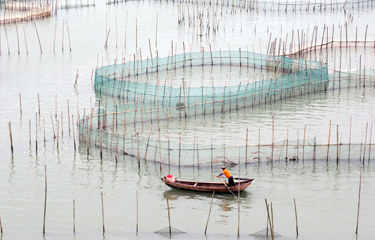It’s unlikely anyone on the average Chinese aquaculture worker’s wages will afford to eat often at “Guo,” a fancy new restaurant which opened recently at the New Century Hotel in Dalian, one of China’s traditional fishing and seafood processing hubs – and the home town of the Zoneco Group.
Punters pay CNY 500 (USD 73.00, EUR 64.76) to sit amid chic décor at a buffet of “Dongbei” treats including lobsters and crabs.
The average annual income for a Chinese fisherman (including aquaculture workers) stood at CNY 18,450 (USD 2,685, EUR 2,390) in 2017. That’s lower than an industrial wage in China – and this in a workforce that is now officially shrinking. And that might explain why so many are exiting the sector.
China claims a total 18.7 million people are active in fisheries, which includes related industries. Other figures suggest five million involved directly in aquaculture. But it’s not clear how long many of the small-time players in the industry – and that huge headcount – will last.
Several factors are combining to radically transform China’s fisheries and aquaculture sector. Most significant among those are a nationwide environmental crackdown and the domestic market’s mounting concern over food safety and the overuse of chemicals and antibiotics in local aquaculture production.
In addition to a clampdown on illegal aquaculture ponds, an extended domestic fishing moratorium, and buyouts of smaller fishing vessels, China has been more actively enforcing its ban on electric pulse fishing. Prosecution of illegal “electric fishing” tops the list of priorities on the 2019 annual “Shining Sword” campaign against illegal fishing in domestic waters. Public displays of confiscated “electrical fishing gear” – in many cases simple car batteries – have been organized in towns across the country. The campaign, run by the Ministry of Agriculture’s regional offices, has also targeted illegal fishing by Chinese fishermen in rivers bordering North Korea and Russia. A ministry document points to a 174 percent year-on-year increase in prosecutions in 2018 out of 34,500 cases, an increase of 130 percent.
The results of increased regulation are showing up in the structure of the aquaculture sector. The country had 7.2 million hectares in aquaculture last year, of which 5.14 million was in fresh-water and 2.04 million hectares in sea-water. The amount of production on from fresh-water lakes dropped 15.8 percent to represent 14.5 percent of China’s total. China produced 64.5 million tons in 2018, up 0.19 percent, of which aquaculture accounted for 49.9 million tons, up 1.73 percent on the previous year. Distant-water fishing contributed 3.5 percent of the total volume, at 2.25 million tons.
The bulk of Chinese aquaculture – 51.8 percent – came from production in earthen ponds covering 2.6 million hectares, up 5.5 percent year-on-year. However, there has been a clear drop in the amount of aquaculture in reservoirs which at 1.4 million hectares now account for 28 percent of production. There’s been an even sharper drop in aquaculture production in rivers – down 16 percent and now accounting for 3.49 percent of production.
Many Chinese research reports project growth of the value of China’s aquaculture output of about 4.4 percent over the next four years. As overall seafood volume starts to plateau – prices continue to outstrip volume – it is likely there will be an increase in productivity.
Even so, output of key species like shrimp looks set to be squeezed as the country is seeking to establish a unified national management plan for mudflats in order to protect nature reserves and drinking water supplies. The plan categorizes mudflats into “prohibited,” “permitted,” and “restricted” for aquaculture licensing purposes with “priority given to ecological concerns,” according to Chen Jiayong, director of the aquaculture division at the Fisheries Administration bureau under the Agricultural Ministry in Beijing.
Additionally, overuse of antibiotics is depressing prices for freshwater seafood, according to fish farmers near Yantai, who pointed to three problems plaguing their industry: use of illegal anti-bacterials like malachite green; use of legal drugs without abiding by withdrawal periods prior to sale; and overuse of drugs during transportation of seafood.
A series of inspections of seafood markets has put the pressure on farmers given that many vendors are returning or not paying for condemned product. A series of messages sent on a producers Wechat group to farmers in Guangdong province warns aquaculture producers to ensure antibiotics standards are met or face non-payment. This year, China’s aquaculture farmers have already been put on antibiotics warning by shrimp and tilapia processors. The “2019 National Aquatic Veterinary Medicine Residue Monitoring Plan” will focus on shellfish and seedlings in 2019.
The “Shining Sword” campaign is part of a larger environmental effort by China that is having the effect of pushing small-time and part-time (and sometimes unscrupulous) players out of its aquaculture sector. It is becoming increasingly difficult to be a small-time player in China’s fisheries industry, given the increasing cost of compliance with the host of environmental and regulatory laws now being enforced more rigidly by the Chinese government, China Agriculture Minister Han Changfu recently told a meeting of regional and national fisheries officials. Changfu mentioned the fact that China has eliminated 40,000 trawlers since 2012.
China’s prioritization of environmental standards comes its hyper-intensive fishing and aquaculture efforts resulted in extensive damage to its coastal and inland waters. As the country shifts to policies that favor large companies and state-backed conglomerates in an effort to standardize the seafood sector, more and more small-time operators who, for good and for ill, made China the world’s top seafood producer will be pushed aside. A new generation, backed by connections, by finance, and by innovation are likely replace them.







